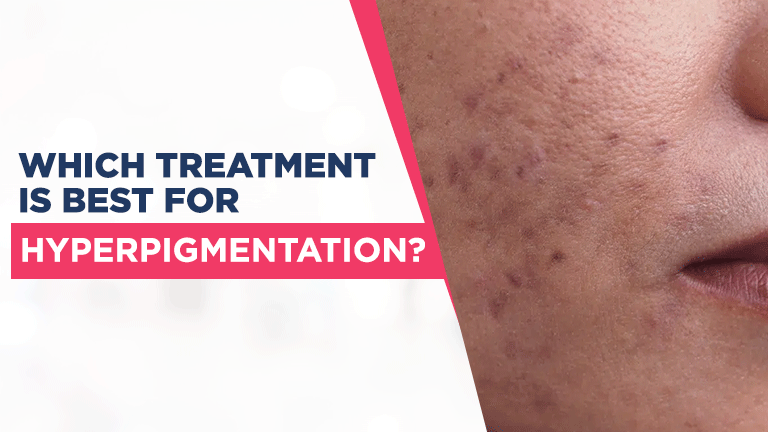
How long before the wedding should a bride get a HydraFacial?
All brides desire to have glowing, redless skin on the

A common skin condition called hyperpigmentation is defined by the darkening of specific skin areas as a result of an overabundance of melanin, the pigment that gives skin its color. This condition can affect people of all skin types and can appear on various parts of the body, including the face, hands, and other areas frequently exposed to the sun.
Understanding the various treatment options for hyperpigmentation is crucial for effectively managing the condition and achieving clearer, more even-toned skin. Treatment effectiveness can vary based on the type and cause of hyperpigmentation, as well as individual skin type and tone. With a range of available treatments, from topical creams to advanced dermatological procedures, knowing the most suitable options helps in making informed decisions and setting realistic expectations.
Hyperpigmentation can manifest in several distinct forms, each with unique characteristics and underlying causes:
Post-inflammatory Hyperpigmentation (PIH):
Post-inflammatory hyperpigmentation (PIH) occurs when the skin darkens following an injury or inflammation, such as acne, eczema, or a burn. The affected area produces more melanin as it heals, leading to darker patches that can persist for months or even years.
Melasma:
Melasma is characterized by larger, darker patches typically found on the face. It is often triggered by hormonal changes, such as those occurring during pregnancy (often referred to as “the mask of pregnancy”) or with the use of oral contraceptives. Sun exposure can exacerbate melasma, making it more challenging to treat.
Sunspots (Solar Lentigines):
Sunspots, also known as solar lentigines or liver spots, are small, darkened patches that develop on areas frequently exposed to the sun, like the face, hands, shoulders, and arms. They are most common in older adults and are caused by prolonged ultraviolet (UV) radiation exposure.
Age Spots:
Age spots, often overlapping with sunspots, appear as flat, dark areas on the skin. They typically occur in individuals over 50 and result from the cumulative effects of sun exposure over time. Unlike sunspots, age spots are directly related to the aging process.
Causes and Risk Factors in Hyperpigmentation
Hyperpigmentation can result from various factors, with some people being more predisposed due to their skin type or genetic makeup:
Sun Exposure:
One of the most significant contributors to hyperpigmentation is sun exposure. UV rays stimulate the production of melanin as a protective response, leading to darkened areas over time. Consistent use of sunscreen can help mitigate this risk.
Hormonal Changes:
Hormonal fluctuations, particularly during pregnancy, menopause, or with the use of certain medications like birth control pills, can lead to hyperpigmentation. These hormonal changes can stimulate an increase in melanin production, causing conditions like melasma.
Skin Injuries and Inflammation:
Any injury or inflammation, such as cuts, burns, acne, or eczema, can trigger an overproduction of melanin in the healing process, resulting in post-inflammatory hyperpigmentation. This type is common in individuals with darker skin tones, who naturally have more active melanocytes.
Genetic Predisposition:
Genetics play a crucial role in determining how susceptible an individual is to hyperpigmentation. People with a family history of hyperpigmentation disorders are more likely to develop similar conditions, especially when exposed to the same environmental triggers.
Topical Treatments
Topical treatments are a popular and accessible option for managing hyperpigmentation. These treatments can be divided into over-the-counter (OTC) and prescription options, each offering various active ingredients and benefits.
OTC treatments for hyperpigmentation often contain ingredients that help lighten dark spots and even out skin tone. Here are some common and effective ingredients:
Known for its antioxidant properties, vitamin C helps reduce melanin production and brightens the skin. It also protects against UV damage, making it a valuable addition to any skincare routine.
Derived from vitamin A, retinoids increase cell turnover, promoting the shedding of pigmented skin cells and the growth of new, evenly pigmented skin.
Also known as vitamin B3, niacinamide inhibits the transfer of melanin to skin cells, helping to prevent and reduce the appearance of dark spots.
Contains glabridin, which helps to inhibit melanin production and reduce pigmentation. It also has anti-inflammatory properties.
For more stubborn or severe cases of hyperpigmentation, dermatologists may prescribe stronger treatments. These options typically have higher concentrations of active ingredients and require medical supervision.
A potent skin lightener that inhibits tyrosinase, an enzyme crucial for melanin production. It’s considered one of the most effective treatments for hyperpigmentation.
A powerful retinoid that promotes cell turnover and helps fade hyperpigmentation by accelerating the removal of pigmented cells.
Naturally found in grains, azelaic acid helps to reduce inflammation and hyperpigmentation. It also has antibacterial properties, making it useful for acne-prone skin.
Often combined with other treatments like hydroquinone, corticosteroids help to reduce inflammation and can enhance the effectiveness of other depigmenting agents.
Topical treatments offer a range of options for addressing hyperpigmentation, from mild OTC products to potent prescription medications. Understanding the benefits and limitations of each can help in selecting the most appropriate treatment for individual needs and skin types.
Professional Treatments
For those seeking more immediate and pronounced results, professional treatments for hyperpigmentation are available.
Chemical peels involve applying a chemical solution to exfoliate the skin. There are three types: superficial, medium, and deep peels. Superficial peels use mild acids for gentle exfoliation, with minimal downtime. Medium peels use stronger acids, suitable for moderate hyperpigmentation, requiring a recovery period of a week or more. Deep peels employ potent acids for severe cases and demand an extended recovery period. These peels work by exfoliating the top skin layers, promoting new skin growth, and results can range from mild redness for superficial peels to significant peeling for deep peels.
Laser Therapy
Laser therapy utilizes concentrated light beams to target and break down pigmented cells. Fractional lasers target small areas of the skin, promoting collagen production with minimal downtime. Q-switched lasers break down melanin without damaging surrounding tissue, making them effective for treating dark spots. Lasers work by breaking down melanin and stimulating collagen production, offering precise targeting and improved skin texture. The recovery period varies, ranging from a few days to a couple of weeks, depending on the laser type.
Microdermabrasion involves gentle exfoliation using a handheld device with fine crystals or a diamond tip, suitable for all skin types with minimal downtime. Dermabrasion is a more intensive procedure using a rotating instrument to remove deeper skin layers, typically recommended for severe cases and lighter skin tones to minimize scarring risks. Microdermabrasion results in smoother skin with minimal recovery, while dermabrasion offers significant improvement in severe hyperpigmentation but requires a longer recovery period with redness and swelling lasting several weeks.
Microneedling uses fine needles to create micro-injuries in the skin, stimulating collagen production and enhancing the absorption of topical treatments. This process effectively treats various types of hyperpigmentation, especially when combined with serums like vitamin C or hyaluronic acid. Post-treatment care includes avoiding sun exposure, using gentle skincare products, and keeping the skin hydrated. Redness and mild swelling are common immediately after treatment, typically subsiding within a few days, resulting in improved skin texture and reduced pigmentation.
Home remedies for hyperpigmentation often involve natural ingredients that are believed to lighten dark spots and even out skin tone. Popular ingredients include aloe vera, turmeric, and apple cider vinegar.
However, while some evidence supports the efficacy of these ingredients, their results can be inconsistent, and safety considerations are important. It is crucial to perform patch tests before use to avoid irritation or allergic reactions.
Ayurvedic and traditional medicine practices offer various treatments for hyperpigmentation using natural herbs and remedies. Common practices include the use of herbs like manjistha (Rubia cordifolia), neem, and sandalwood. These herbs are often applied as pastes or oils to the skin to reduce pigmentation.
Scientific support for these treatments varies; while some studies suggest their efficacy, comprehensive clinical evidence is often limited. Safety profiles of these treatments are generally good, especially when used in their natural forms.
However, as with all treatments, it is essential to consult with a healthcare professional before starting any new regimen to ensure it is safe and appropriate for individual skin types and conditions.
In short, topical therapies like creams, serums, and lotions are the most common treatment for hyperpigmentation. However, when combined with professional treatments like chemical peels, laser therapy, microdermabrasion, and microneedling, you can achieve faster and more pronounced results.
These treatments offer a range of options to address different types and severities of hyperpigmentation. Topical treatments provide accessible and targeted solutions, while professional interventions can enhance and accelerate skin improvement. Natural and alternative remedies can also complement these approaches, but it should be used with caution and awareness of their varying effectiveness.
Finally, for expert guidance and advanced treatments to tackle hyperpigmentation, visit Eximus Clinic. Our team of specialists will help you achieve clearer, more radiant skin with personalized care and advanced solutions. Book your appointment now!

All brides desire to have glowing, redless skin on the
Dreaming of a sculpted body but struggling with stubborn fat
Struggling with severe hair loss or balding? At Clinic Eximus
Struggling with dull, tired skin? At Clinc Eximus , we
Struggling with hair thinning or excessive hair fall? At Clinic
Flawless skin isn’t just a dream—it’s a choice. Many turn